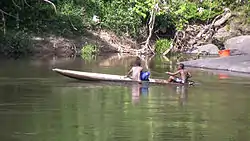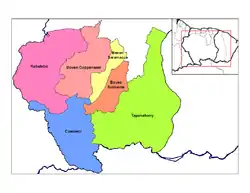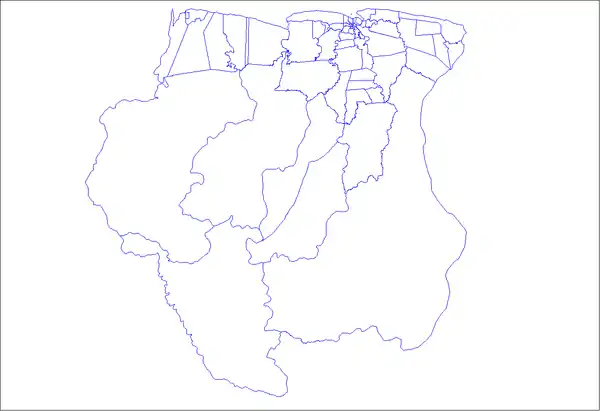Sipaliwini District
Sipaliwini is the largest district of Suriname, located in the south. Sipaliwini does not have a regional capital as it is directly administered by the national government in Paramaribo.[2]
Sipaliwini | |
|---|---|
 | |
_(hatched).svg.png.webp) Map of Suriname showing Sipaliwini district (claimed territory in hatched area) | |
| Coordinates: 3°47′N 56°02′W | |
| Country | |
| Area | |
| • Total | 130,567 km2 (50,412 sq mi) |
| Population (2012 census)[1] | |
| • Total | 37,065 |
| • Density | 0.28/km2 (0.74/sq mi) |
| Time zone | UTC-3 |
History
Sipaliwini was created in 1983[2] and has a population of 37,065 and an area of 130,567 km2.[1] The district is nearly 4 times as large as the other 9 districts of Suriname combined; however, most of the Sipaliwini is almost completely covered by rainforest.[3] To create the district, the Nickerie District was reduced from 65,000 km2 to 5,000 km2.[4] Sipaliwini is the tribal area inhabited by Maroons and indigenous people.[1] Various peace treaties starting in 1686 had recognised autonomy for the tribes over their own area, however a specific delineation of the tribal area had been lacking. The name is of Amerindian origin, refers to the Sipaliwini River, and means river of stones or river of rocks.[5]
It is thought by archaeologists that hunter-gatherers lived in what is today Sipaliwini district during the Paleolithic period.[2] The region was largely left alone during the colonial period, as the Dutch that controlled Suriname were fearful of the Portuguese in Brazil, and it was not until the 20th century that development projects began.
As of 2004, there are 41 schools in the areas. An increase in schools is planned, because some children have to travel long distances by foot or boat to neighbouring villages.[3] As of 2004, there are 24 clinics in the district.[3] Medical care is provided by Medische Zending.[6] In the 1950s, Operation Grasshopper established many tiny airstrips in the district in order to make the territory accessible.[7]
Sipaliwini district had seen occasional fighting in the late 1960s between Guyanese and Surinamese troops over border disputes in the south-west Tigri Area of the Coeroeni resort.[8]
Nature
Sipaliwini consists of large areas of tropical rain forests, mountains, and savannas. In 1998, the Central Suriname Nature Reserve was created by Conservation International and the government of Suriname from the fusion of three existing nature reserves: Ralleighvallen, Tafelberg and Eilerts de Haangebergte.[9] It was designated a UNESCO World Heritage Site in 2000 for its pristine tropical rainforest ecosystem. It is known for its rapids and bird species, including the Guiana Cock of the Rock (Rupicola rupicola).[10] Over 5,000 different plants have been identified, and large mammals like the jaguar, giant armadillo, and eight species of primates.[11] A research station is located at the foot of Voltzberg and the area is tourist attraction.[10]
The Sipaliwini Savanna Nature Reserve has been established in 1972, and is 1,000 square kilometres of savannah, and the second largest in Suriname. The reserve is near pristine and offers a wide variety in flora and fauna.[12]
Administration
Until 2011, Sipaliwini was administered by one district commissioner residing in Paramaribo. In the years since, district commissioners have been appointed for each separate resort.[3]
Resorts

Sipaliwini is divided into 7 resorts (ressorten):
| District | District Commissioner[13] | Main tribes |
|---|---|---|
| Boven Coppename | Ludwig Mettendaf (since 2016) | Kwinti and Tiriyó[14] |
| Boven Saramacca | Yvonne Pinas (since 2016) | Matawai[3] |
| Boven Suriname | Humphrey Jeroe (since 2019) | Saamaka[3] |
| Coeroeni | Trees Cirino (since 2019) | Tiriyó[15] |
| Kabalebo | Joanna Aroepa (since 2019) | Arawak and Warao[3] |
| Pamacca | Margaretha Malontie (since 2016) | Paramacca[16] |
| Tapanahoni | August Bado (since 2016) | Ndyuka[3] |
Villages
.jpg.webp)
The district contains 156 villages.[3] All of them except for Stoelmanseiland and Antonio do Brinco are tribal.
- Abenaston
- Alalapadu
- Amatopo
- Antonio do Brinco
- Apetina
- Apoera
- Asidonhopo
- Aurora
- Bakhuys
- Benzdorp
- Bitagron
- Botopasi
- Corneliskondre
- Cottica
- Diitabiki
- Godo Holo
- Jaw Jaw
- Kajana
- Kasuela (disputed)
- Kawemhakan
- Kuruni
- Kwamalasamutu
- Kumakahpan
- Langatabiki
- Lucie
- Moitaki
- Nieuw Jacobkondre
- Paloemeu
- Pelelu Tepu
- Pikin Slee
- Pïleike
- Poeketi
- Poesoegroenoe
- Pokigron
- Sandlanding
- Sipaliwini
- Stoelmanseiland
- Tutu Kampu
- Vier Gebroeders
- Wanapan
- Washabo
References
- "Resorts in Suriname Census 2012" (PDF). Retrieved 27 May 2020.
- "Distrik Sipaliwini 1". Suriname.nu (in Dutch). Retrieved 28 May 2020.
- "Structuur Analyse" (PDF). Planning Office Suriname (in Dutch). Retrieved 28 May 2020.
- "Districtenindeling Suriname - herstel oude grenzen district Nickerie". nickerie.net (in Dutch). Retrieved 28 May 2020.
- "IMWO Voorstudie Sipaliwin" (PDF). Decentralisatie (in Dutch). Retrieved 15 July 2020.
- Map of MZ healthcare centres
- "Operatie sprinkhaan" (PDF). Landewers (in Dutch). Retrieved 28 May 2020.
- "Een halve eeuw Tigri". Star Nieuws via Shoeket (in Dutch). Retrieved 28 May 2020.
- "Central Suriname Nature Reserve". Tropical Ecology Assessment and Monitoring (TEAM) Network. Retrieved 4 September 2015.
- Nature Reserve of Suriname Visit Suriname
- "Central Suriname Nature Reserve". Unesco.org. Retrieved 27 May 2020.
- "Natuurreservaten Suriname". Reis Graag (in Dutch). Retrieved 28 May 2020.
- "DNA en districten". De Nationale Assemblée (in Dutch). Retrieved 1 June 2020.
- Migge, Bettina; Léglise, Isabelle (2013). Exploring Language in a Multilingual Context: Variation, Interaction and Ideology in Language Documentation. New York: Cambridge University Press.
- "DORPSPLAN KWAMALASAMUTU 2011–2014" (PDF). Institute for Graduate Studies and Research (IGSR) (in Dutch). Retrieved 27 May 2020.
- "Paamaka en Ndyuka leggen grens vast". Regional Development.gov.sr (in Dutch). Retrieved 23 May 2020.
External links
| Wikimedia Commons has media related to Sipaliwini District. |
